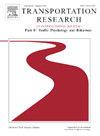超速行为的相关因素:文献综述和荟萃分析
IF 3.5
2区 工程技术
Q1 PSYCHOLOGY, APPLIED
Transportation Research Part F-Traffic Psychology and Behaviour
Pub Date : 2024-10-24
DOI:10.1016/j.trf.2024.10.010
引用次数: 0
摘要
背景超速是最危险的违法行为之一,每年都会造成严重的人员伤亡。为此,一些研究工作集中于理解和解释超速行为。计划行为理论(Theory of Planned Behavior,TPB)被广泛用于理解和解释人类的几种行为,该理论基于三个主要结构:态度、主观规范和感知行为控制。本研究以计划行为理论为基础,旨在通过筛选和分析文献中的相关研究结果,确定超速行为的主要决定因素。结果所获得的结果表明,除了原始 TPB 的三个标准建构外,道德规范和过去的行为也应作为超速意图和行为的关键决定因素。这一发现将有助于制定更有效的行为改变干预措施,通过考虑道德规范和过去行为的影响来鼓励人们遵守限速规定。本文章由计算机程序翻译,如有差异,请以英文原文为准。
Factors associated with speeding behavior: Literature review and meta-analysis
Background
Exceeding speed limits is one of the most dangerous violations, causing severe injuries and many deaths every year. For that, several research works focused on understanding and explaining speeding behavior. The Theory of Planned Behavior (TPB) is widely used to understand and explain several human behaviors based on three primary constructs: attitudes, subjective norms, and perceived behavioral control. However, several studies have used different versions of the TPB to explain and understand speeding behavior, which constitutes a source of confusion for researchers and intervention designers.
Objective
Based on the Theory of Planned Behavior, this study aimed to identify the main determinants of speeding behavior by screening and analyzing the results of relevant studies in the literature.
Methods
A literature review will identify relevant research related to using TPB to explain and understand speeding behavior. Subsequently, a meta-analysis will synthesize and combine the results of the selected studies, providing an improved TPB model of speeding behavior.
Results
The obtained results suggest that in addition to the three standard constructs of the original TPB, moral norms and past behavior should be included as key determinants of speeding intention and behavior.
Conclusion
Moral norms and past behavior have been found to be key determinants of speeding behavior. This finding will contribute to the development of more effective behavior change interventions aimed at encouraging adherence to speed limits by taking into account the influence of moral norms and past behavior.
求助全文
通过发布文献求助,成功后即可免费获取论文全文。
去求助
来源期刊
CiteScore
7.60
自引率
14.60%
发文量
239
审稿时长
71 days
期刊介绍:
Transportation Research Part F: Traffic Psychology and Behaviour focuses on the behavioural and psychological aspects of traffic and transport. The aim of the journal is to enhance theory development, improve the quality of empirical studies and to stimulate the application of research findings in practice. TRF provides a focus and a means of communication for the considerable amount of research activities that are now being carried out in this field. The journal provides a forum for transportation researchers, psychologists, ergonomists, engineers and policy-makers with an interest in traffic and transport psychology.

 求助内容:
求助内容: 应助结果提醒方式:
应助结果提醒方式:


